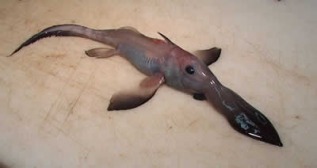 Rhinochimaeridae Rhinochimaeridae Here's another weird and wonderful denzien of the oceans for you to to look at: Rhinochimaeridae, or the Long-Nosed Chimera fish. In South Africa, it is also known as the Ghost Shark. This fishy lives from 200 to over 2,000 meters below sea-level, nearly 8,000 feet down in the abyss. The long nose has many sensory endings used to locate small fish for it to eat. It also has a poisonous spike protruding from the first dorsal fin, which is mildly toxic and thought to be for defence purposes. Very little seems to be known about these odd fish, but here is a link to a scientific paper which gives info about all of the Chimera order. Happy fishing!
1 Comment
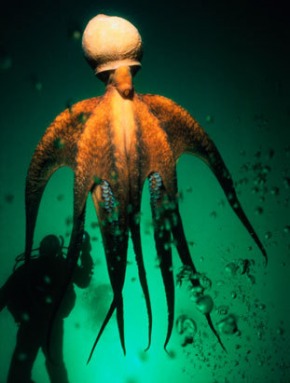 Giant Pacific Octopus Giant Pacific Octopus "Oh my hat!" said the presenter upon seeing the Giant Octopus. Oh my hat indeed! This giant beautiful creature can live for up to 5 years, and has been know to attack sharks. The largest recorded size was 272kg with a 9m arm span, though they usually grow to about 45kg. They are very intelligent, being able to undo sealed containers and suchlike, and can learn by observation, a trait unknown in other invertebrates. They are also extremely inquisitive: In the video you can see how the octopus investigates the diver. Apparently, their turquoise blood is not a good oxygen carrier, hence their need to live in the cold, deep, oxygen-rich waters. They even have no less than three hearts to help pump their blood around their bodies. For more info, try: National Parks Conservation Association Giant Octopus Fact Sheet Acknowledgements: Image: Jeff Rotman/Stone/Getty Images Video: http://www.youtube.com/user/BBCWorldwide 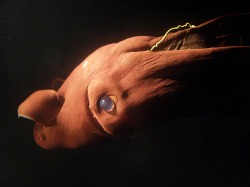 Vampyroteuthis Infernalis Vampyroteuthis Infernalis Deep down in the depths of the abyss, there is a creature, living in the dark, that seems to come straight from our nightmares... It's Vampyroteuthis Infernalis - the Vampire Squid from Hell! It lives in what is known as the Oxygen Minimum Zone, about 600 - 1100m below sea level, and it is the only know member of its order: Vampyromorphidia. They can be anything from black to red in colour, which is in part what gives them their name, and their eyes, which, depending on the light, can be red or a translucent blue, are huge compared to the rest of their body, which reaches a maximum of about 15cm long, and about 30cm with its limbs extended. Originally classified as an Octopus by German teuthologist Carl Chun, it is now believed that the Vampire Squid sits between the classifications of Squid and Octopus. It has eight limbs, but also has the filaments of a squid, which retract into the part of the gelatinous web, between their first and second limbs. It is thought, however, that the filaments are more like the ones lost by the ancient Octopus than those of the modern Squid. Its most interesting feature, however, is its bio-luminescence which it uses for self-defence. One way ol' Vampy does this is by something called counter-luminescence, which means that, when in the shallower part of its habitat, around 600m down, it counters the fact that its silhouette can be seen by predators from below by emmiting light from its own body, effectively cloaking its presence from danger. Another way that it uses this bio-luminescence is in the tips of its limbs. By highlighting areas away from the head and vital organs, if an attack is made, the Vampire can escape with just a mangled limb, which it can regenerate later. It has great control over the photophores on its body, and can cause disorienting flashes or prolonged lighting effects as required. Like most deep water cephalopods, the Vampire has no ink sac, as deep down in the depths, an ink attack would be all but useless. Instead, it can throw out bioluminescent clouds, which can glow for up to 9.5 minutes. These clouds are believed to come from organs on the tips of the limbs. This cloud is only produced in extreme danger, as it takes some time to regenerate the photophores. In the video below, the bit about the Vampire Squid starts at 0:50. Before that, we are treated to a return of one of our favourite animals here at Show Me Something Interesting: The Dumbo Octopus! If you want to read more, here are a few sites to look at: http://tolweb.org/Vampyroteuthis_infernalis/20084 - Great for general information. http://www.biolbull.org/cgi/reprint/205/2/102.pdf - On the production of light in the limb tips. http://jeb.biologists.org/cgi/reprint/201/16/2413.pdf - About the way the Vampire moves. http://www.springerlink.com/content/xj5x22l017552117/fulltext.pdf - About its blood in relation to living in the Oxygen Minimum Zone. This great video from National Geographic shows three rearely seen sharks on video, deep down in the ocean. The Six-Gill Shark is special because most sharks have five gills. Apparently, according to the video, these sharks date back to pre-dinosaur times. This remanent is still going strong. They can grow up to 15 freet long, and can dive as deep as 6000 feet. The Chimera or Ghost Shark is related to both sharks and rays, and could be one of the oldest groups of fish known. There's a video on Youtube showing one with it's egg-sacks out, which is quite astonishing. The Pacific Sleeper Shark can grow up to 25 feet long. Their flesh has a toxin in it that produces symptoms of drunkeness in the humans that eat it. They feed mainly on Giant Squid and Octopus. 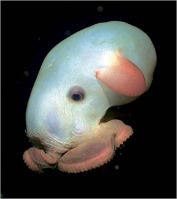 The Dumbo Octopus The Dumbo Octopus This cutey is called the Dumbo Octopus, so named because of its fins which look like the ears of the Walt Disney character. They generally live at depths of 3000 - 4000 meters, but have been sighted at 7000 meters. At about 20cm, they are not that big, but strangely prefer to swallow their prey whole. There are about 37 species in every ocean. Here is a link to the BBC Website page for the Dumbo Octopus for more info. While trawling through YouTube for more wonderful videos of underwater weirdness, I found something truly strange: a video of a Pacific Barreleye fish with a transparent head!! I just had to share it here at Show Me Something Interesting. This is the first time this particular fish has been observed alive, as the only specimens previously seen were dead, dragged to the surface by trawler nets. The first sightings were in 1939. Now, scientists can see this wonderfully strange creature alive and kicking. It is about 6 inches (15cm) long. Here are two sharks, both found off the coast of Japan. What is amazing is that both are 'living fossils,' looking almost as they did in prehistoric times: in fact, many of their close relatives are already extinct. . 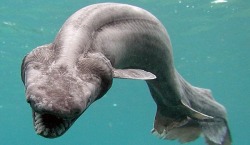 The first is called the Frilled Shark, so-called because of the frilly protrusions from its six gills. It has 25 rows of trident shaped, razor sharp teeth, and looks more like a giant eel than a shark. Males grow to about 1.1 meters, while females can grow to 1.5 meters. The biggest found was about 2 meters long.They normally live between 50 and 1000 meters below sea-level. On Jan 21st, 2007, the shark in the video below was found alive off the coast of Japan. It was ill, and did not adapt to being in the warmer water. It died a couple of hours later. 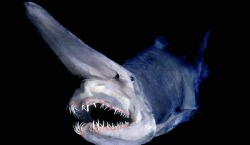 The second of these two wonderful creatures is called the Goblin Shark. They live about 300 - 1000 meters below sea-level, far below the warmth and light of the Sun. It hunts its prey using smell and by sensing the electrical discharges of other animals. It's head is a very unorthodox shape, but its main characteristic are its Alien-like jaws, which come out from its head. Very little is know about it, as it has only very infrequently been observed, although interestingly about 25% of its body is made up of its liver. Wow!! I'm so glad I found this. I remember watching David Attenborough's Blue Planet, and seeing the amazing sight of a bait ball of Sardines get demolished by a collaboration of sharks, dolphins, gannets and a whale. It was awesome. I don't think I had ever considered the possibility of those animals ever working together, yet here it seemed so natural. I think many people owe Mr Attenborough a debt for the work he has done educating the public about the secrets of the various non-human kingdoms. I was lucky enough to meet the man, and I have to say it was one of the best moments of my life so far. The video below is not from the Blue Planet, but it shows a similar set of events. The dolphins swin below the bait ball, blowing bubbles up to keep the sardines from swimming down too low, the sharks circle the wall, and the gannets plunge down from above. Through it all, a Brydes whale scoops up giant mouthfulss of bait. The second video has no whales, but a squadron of seals joins the army.  Deep in the depths of Florida, there is a creature that is not enjoying the best of times. I speak, of course, of the Manatee. Their closest land relatives are the Elephant and the Hyrax, and they are gentle, slow moving creatures. So what's their problem then? Well, it seems that the Manatee has a problem hearing low pitched sounds. This means that the poor creature can't hear the low pulse of the engines of the boats as they move across the water, often resulting in horrific injuries for the Manatee. Now, however, a great new idea has come to the rescue of the Manatee. By fitting high pitched alarms, which the Manatees can hear, to the bottom of the boats, the Manatees can avoid oncoming traffic, and thus avoid injury. Please visit the Save the Manatee Club website for more information about these lovely creatures. |
MOST VIEWED POSTS
© James Edward Hughes 2013
 RSS Feed
RSS Feed





